Abstract
This paper brings some data to bear on the criticisms, claims, and arguments that Skinner (a) denied or dismissed biological participation in behavior, (b) addressed it only late in his career or more often later than earlier, or (c) addressed it only because of the overwhelming evidence for it or the criticisms that he had overlooked it. For this, we coded Skinner's every primary-source publication for three content categories (i.e., genetics, physiology, and evolution) and for the extent to which he addressed them (i.e., in publication titles, substantively, or in passing). Our findings are that Skinner addressed biological participation in over a third of his publications throughout his career, albeit more often later than earlier. The latter, however, is accounted for by an increase in his base rate of publication and in general conditions and specific events in his career, psychology, and science. The discussion addresses our research methods; the reasons for and refutations of the criticisms, claims, and arguments; and their sources.
Keywords: B. F. Skinner, biology, genetics, physiology, evolution, ethology, misrepresentation
Full text
PDF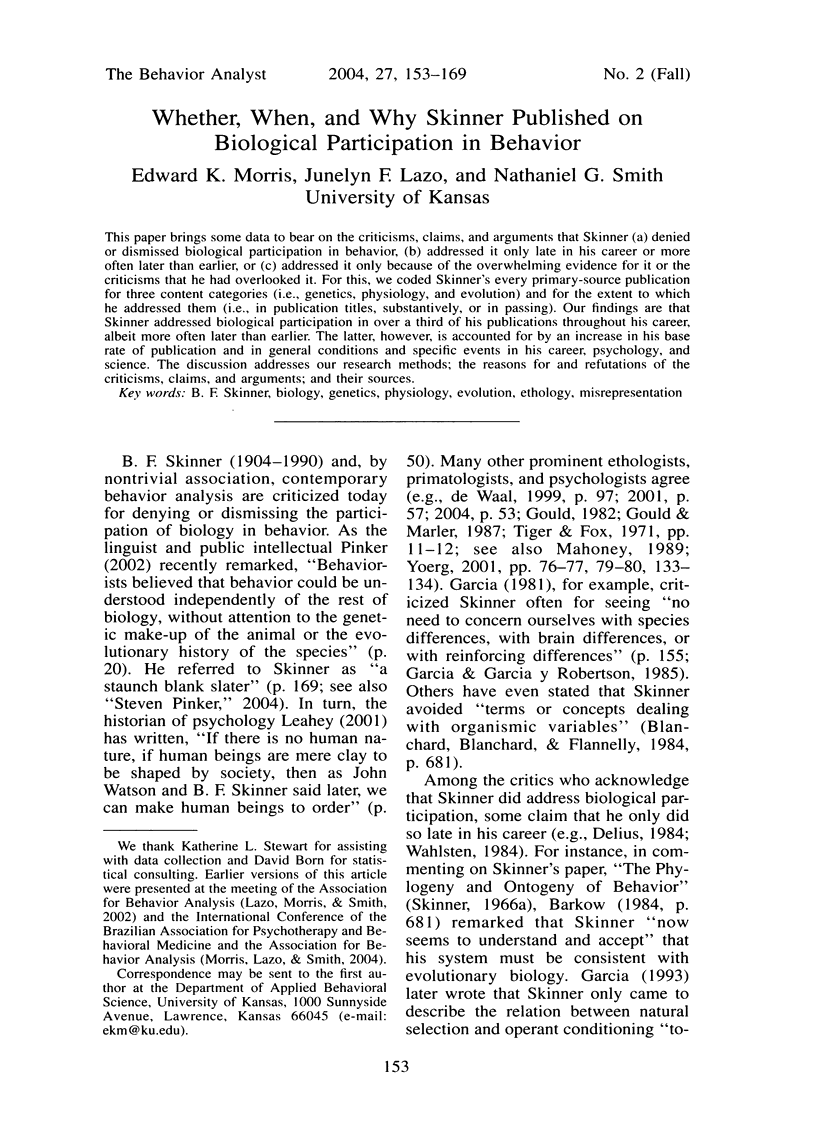
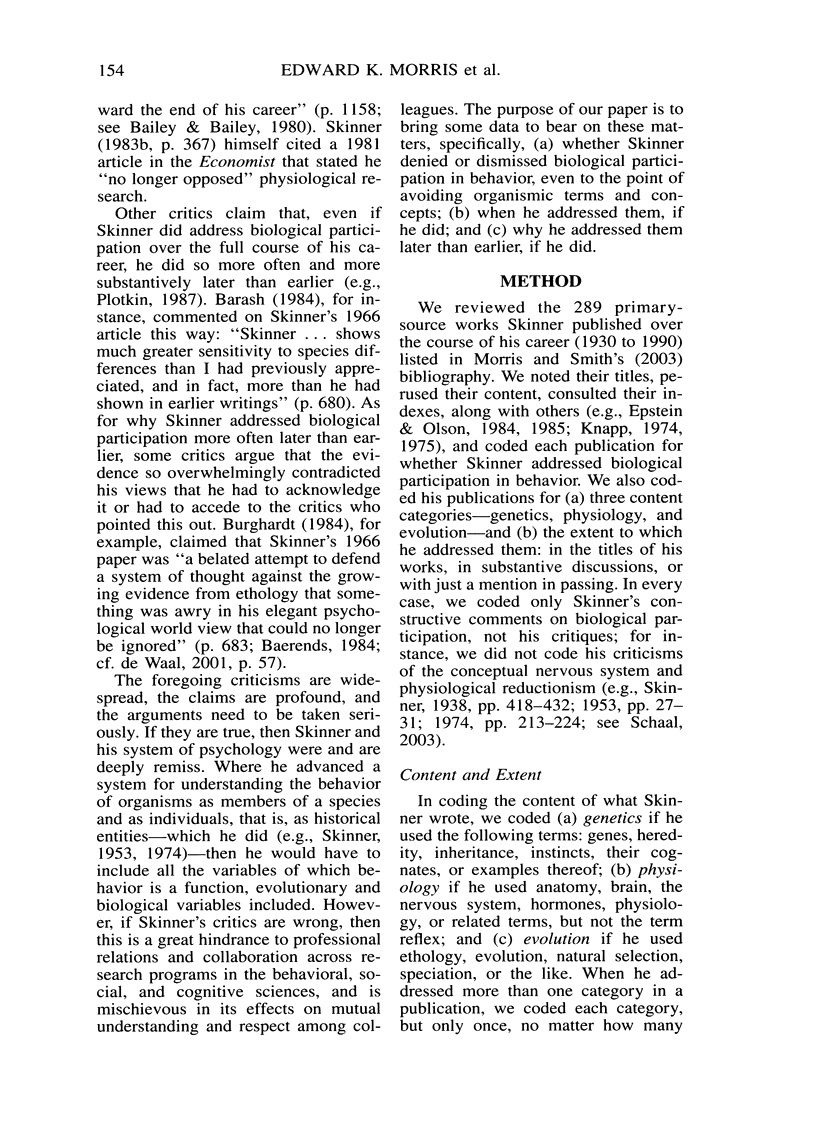

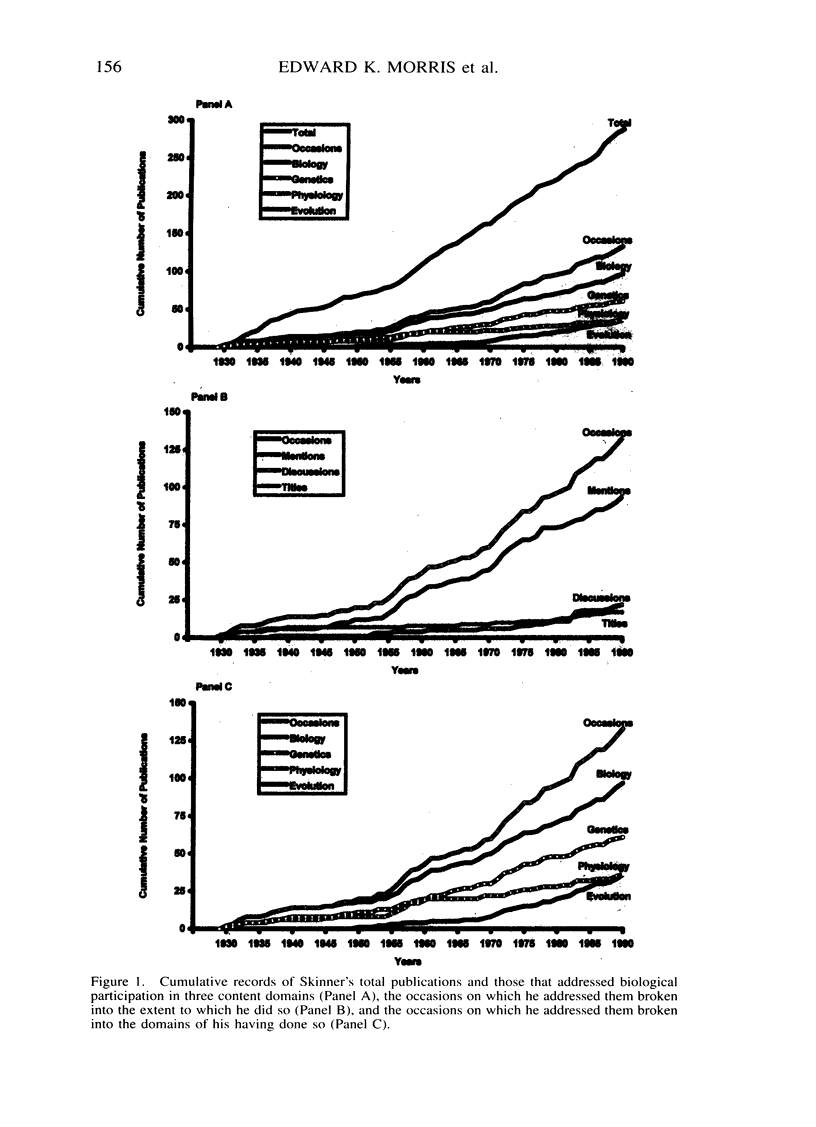
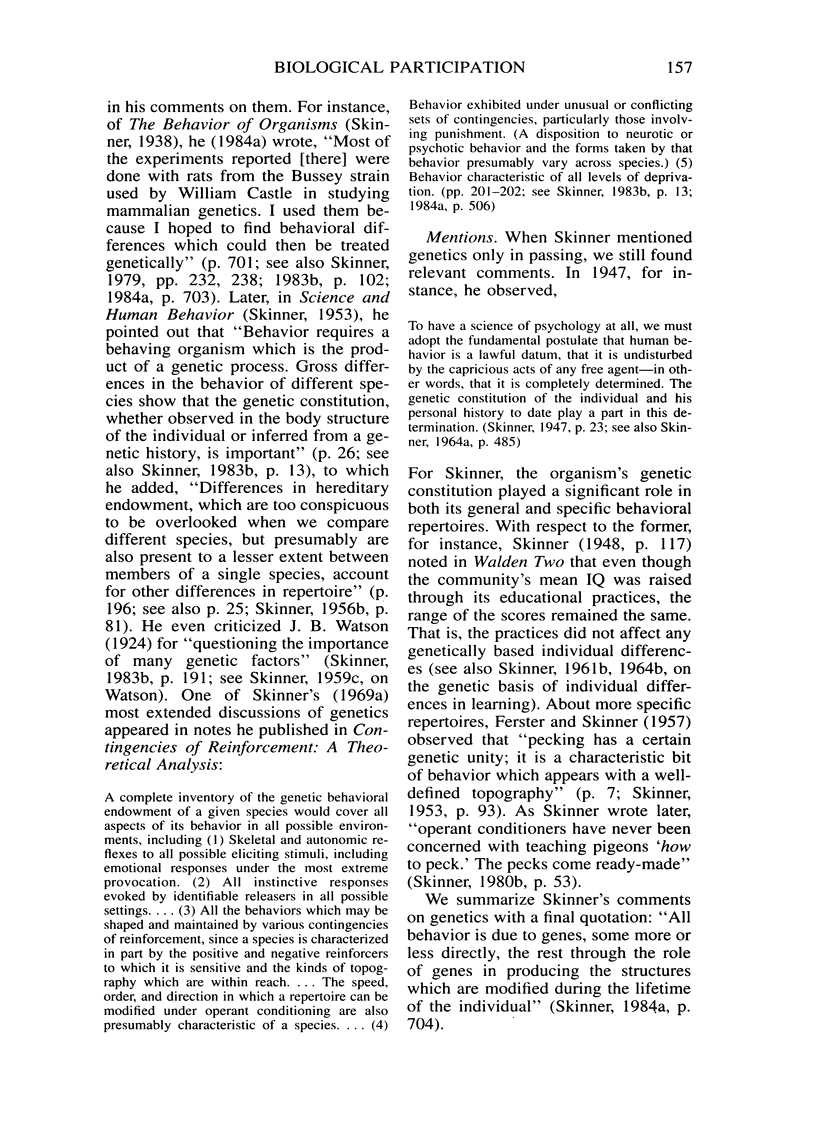
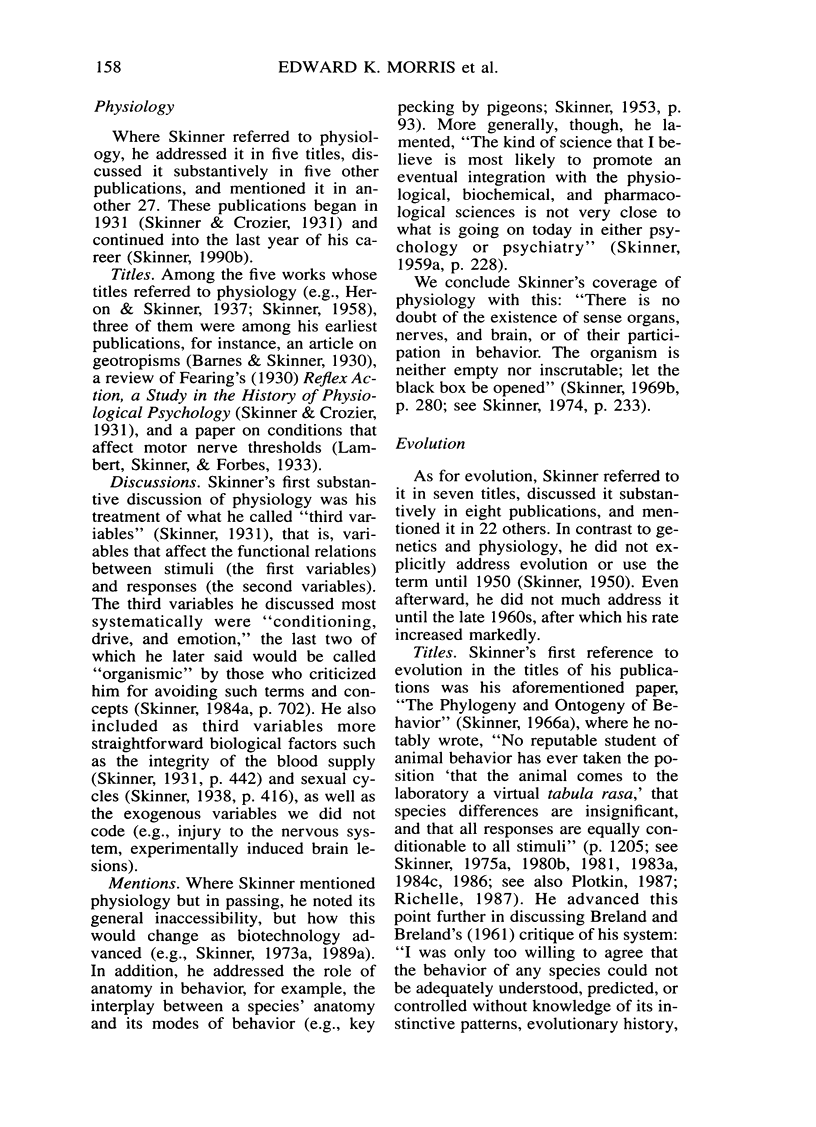
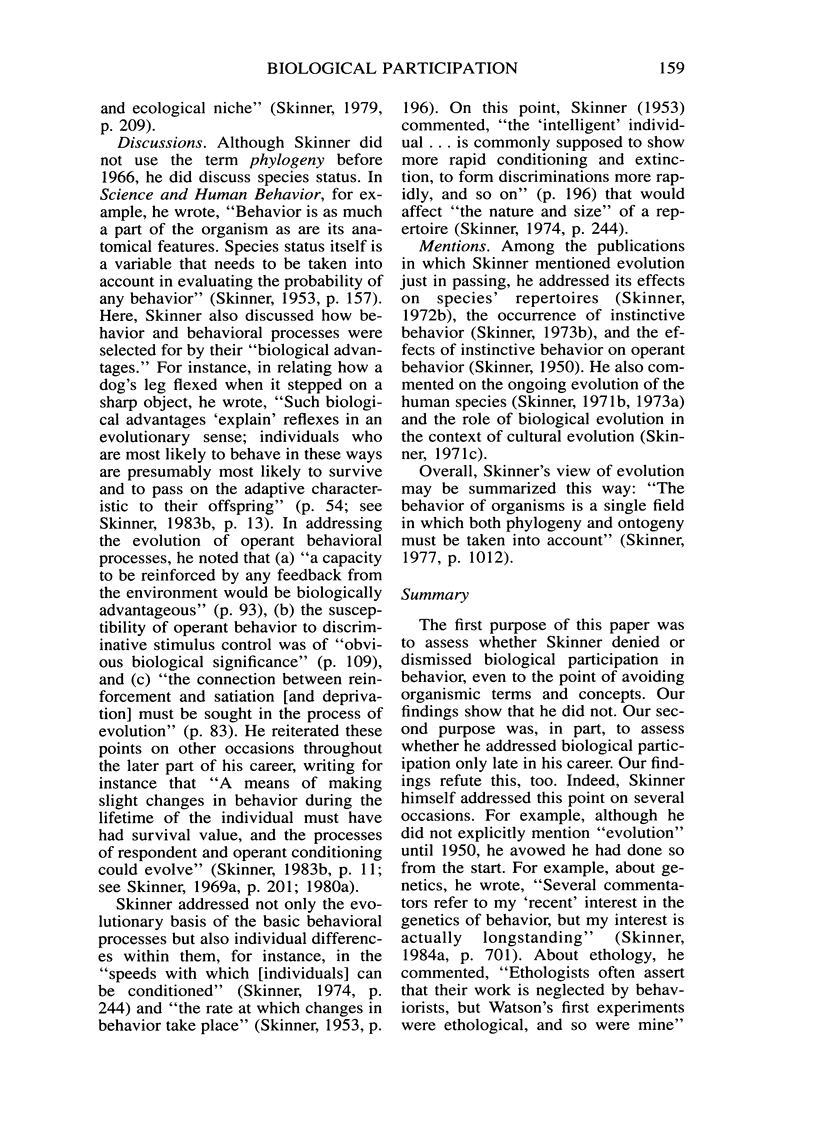
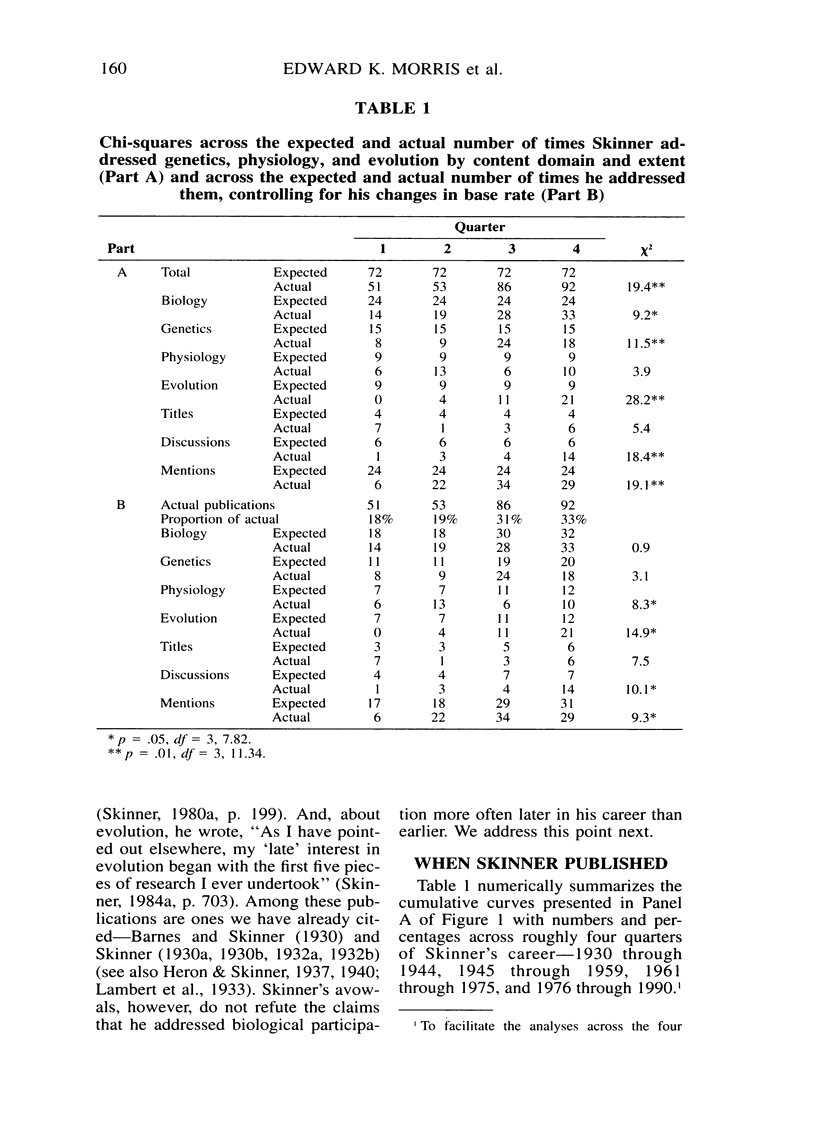
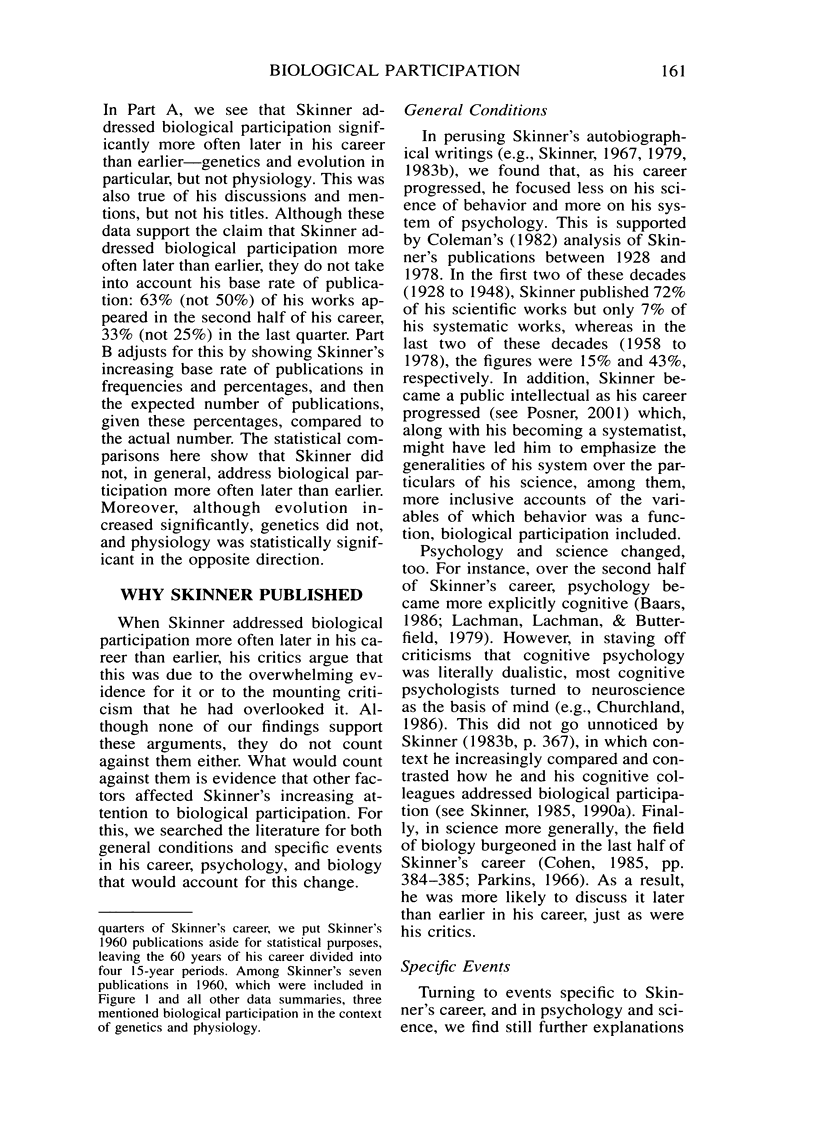
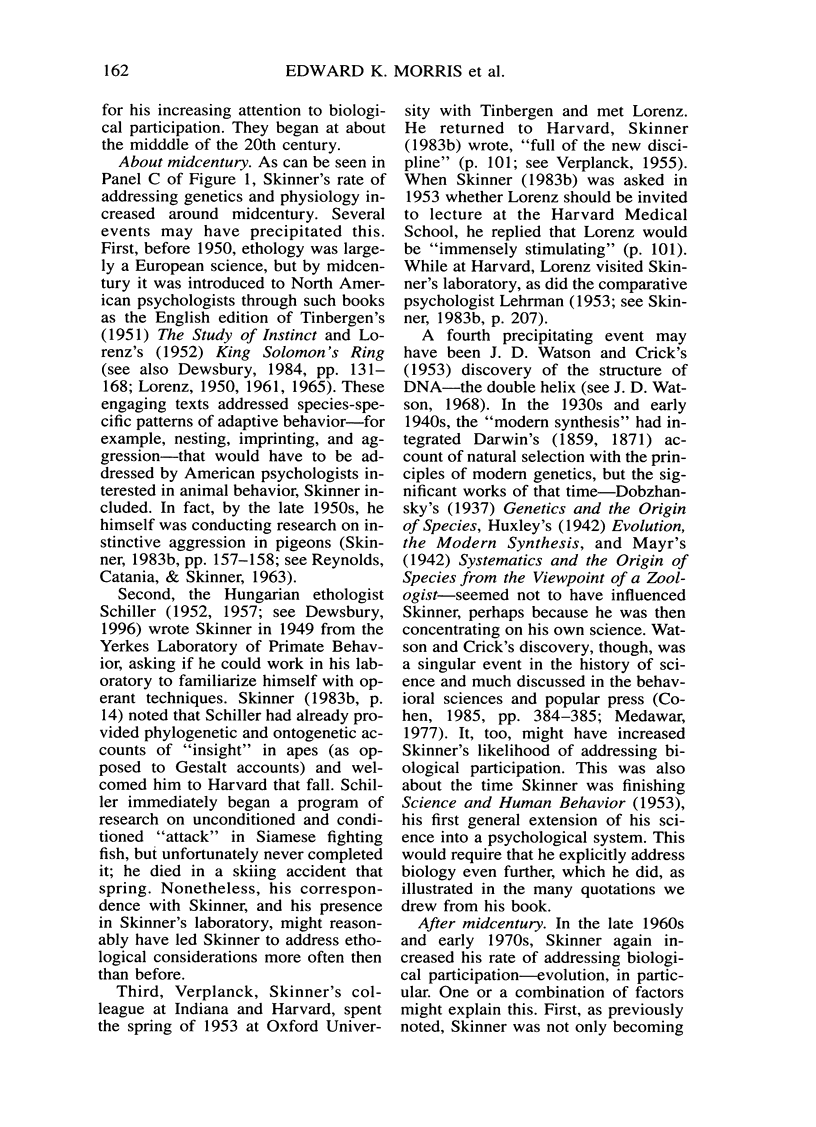
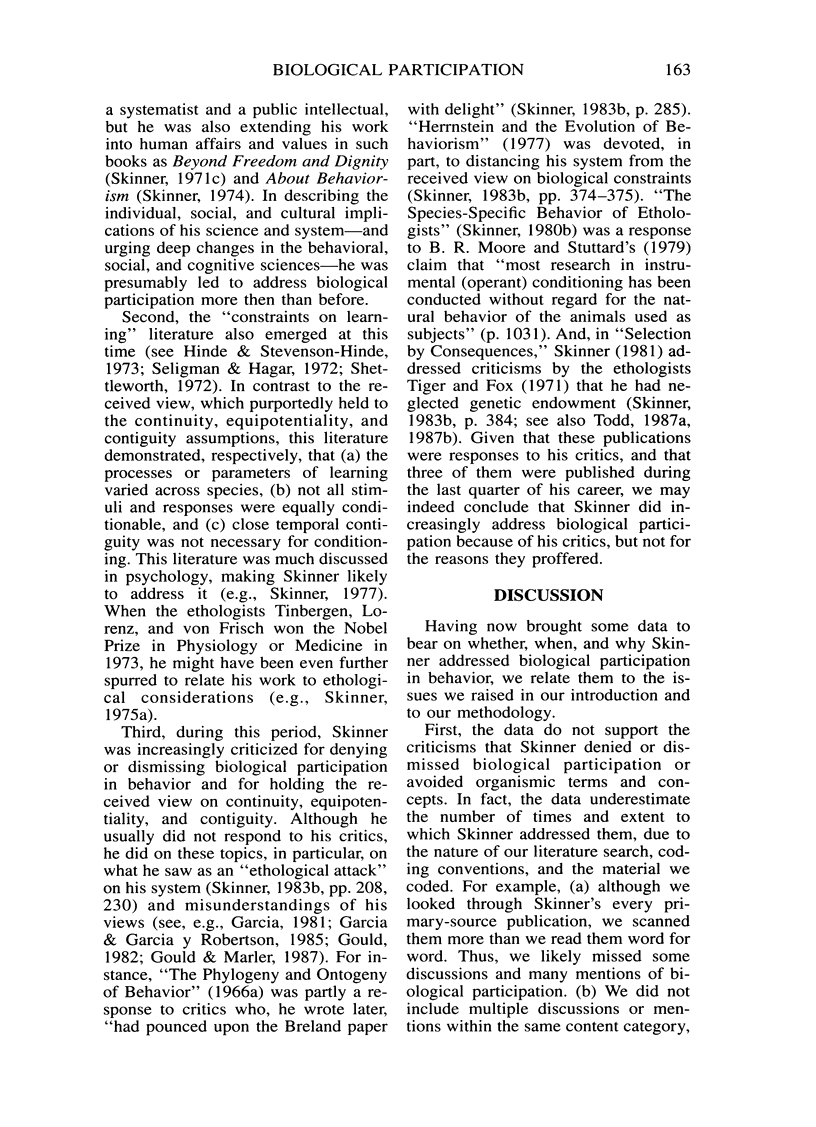
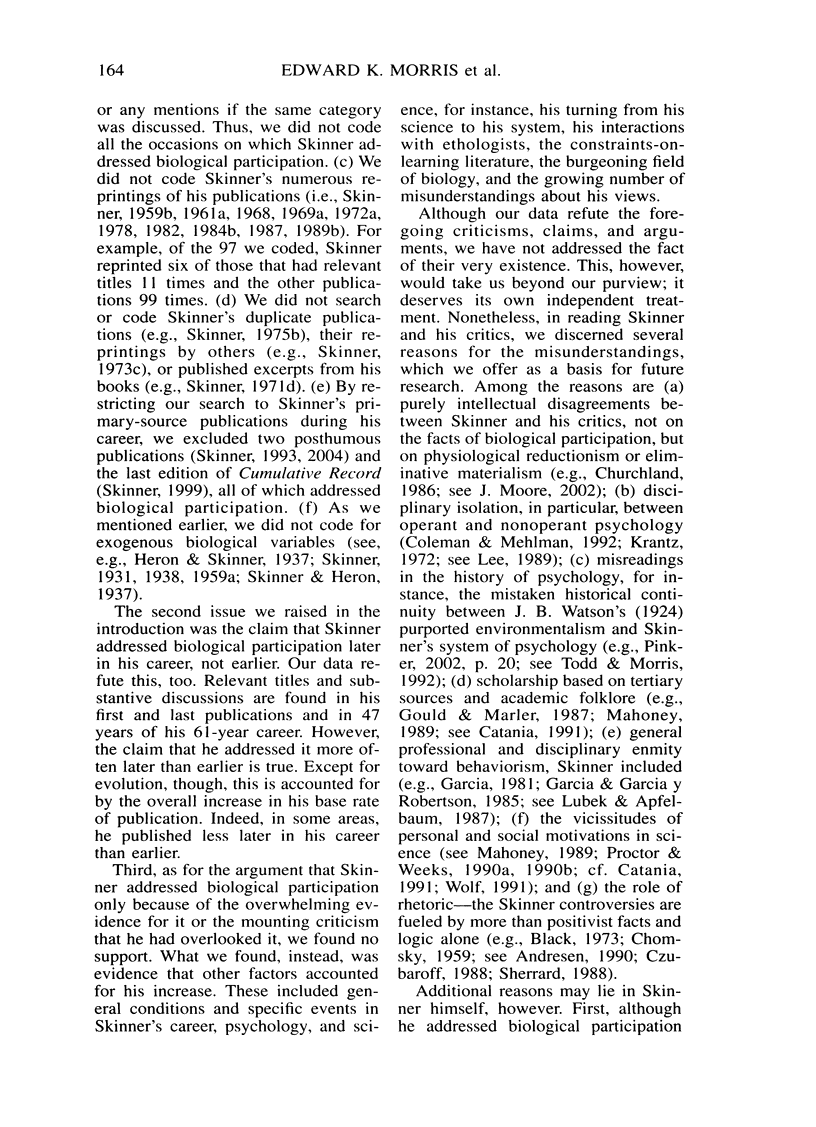
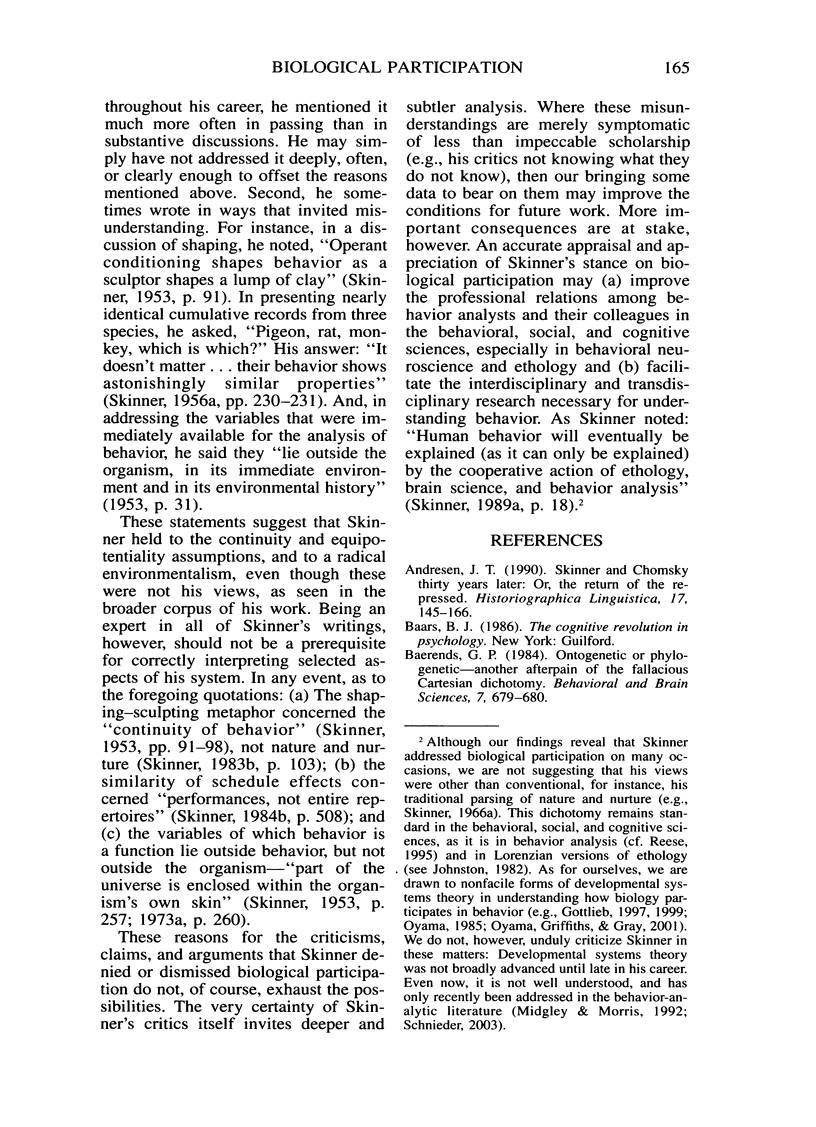
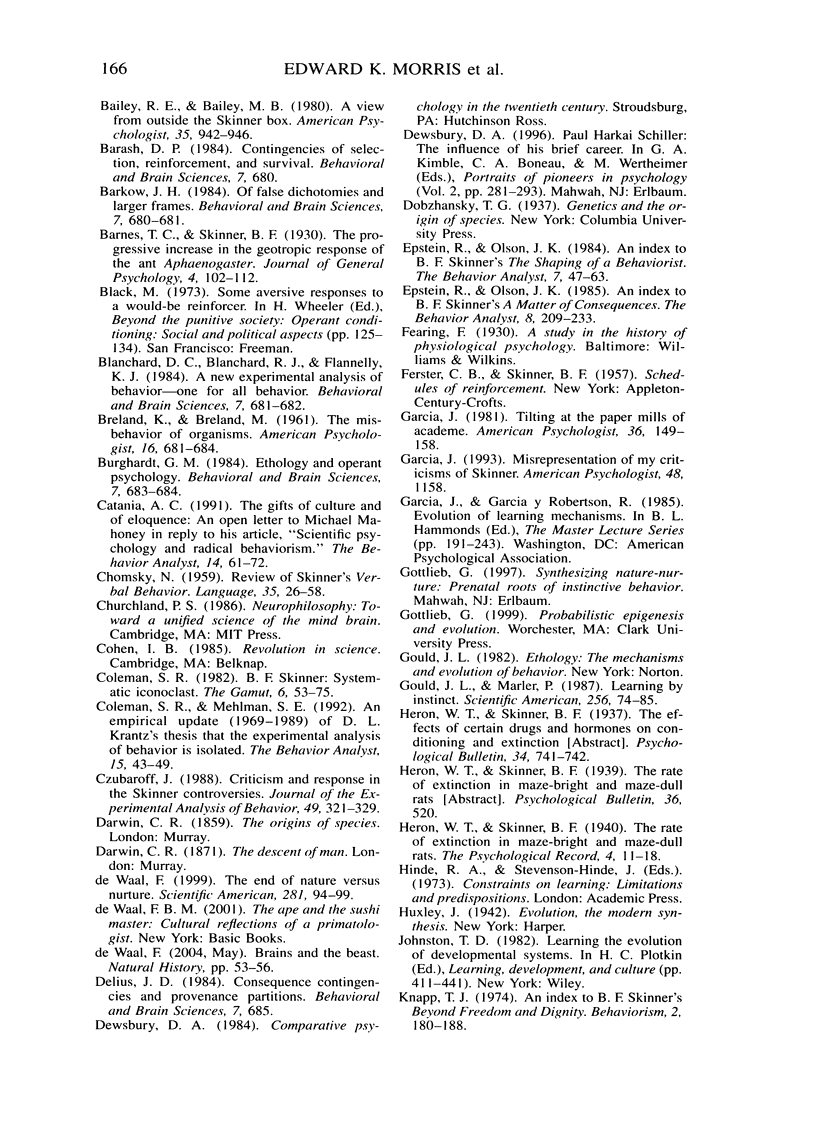
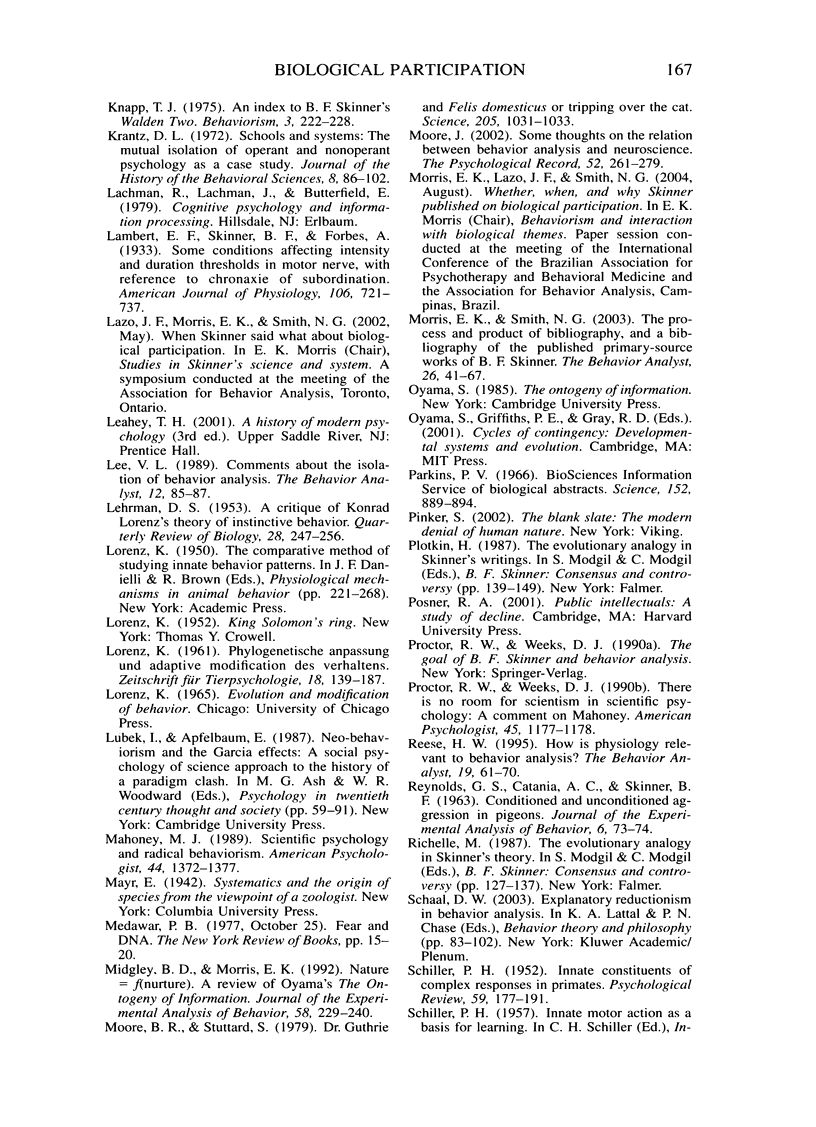
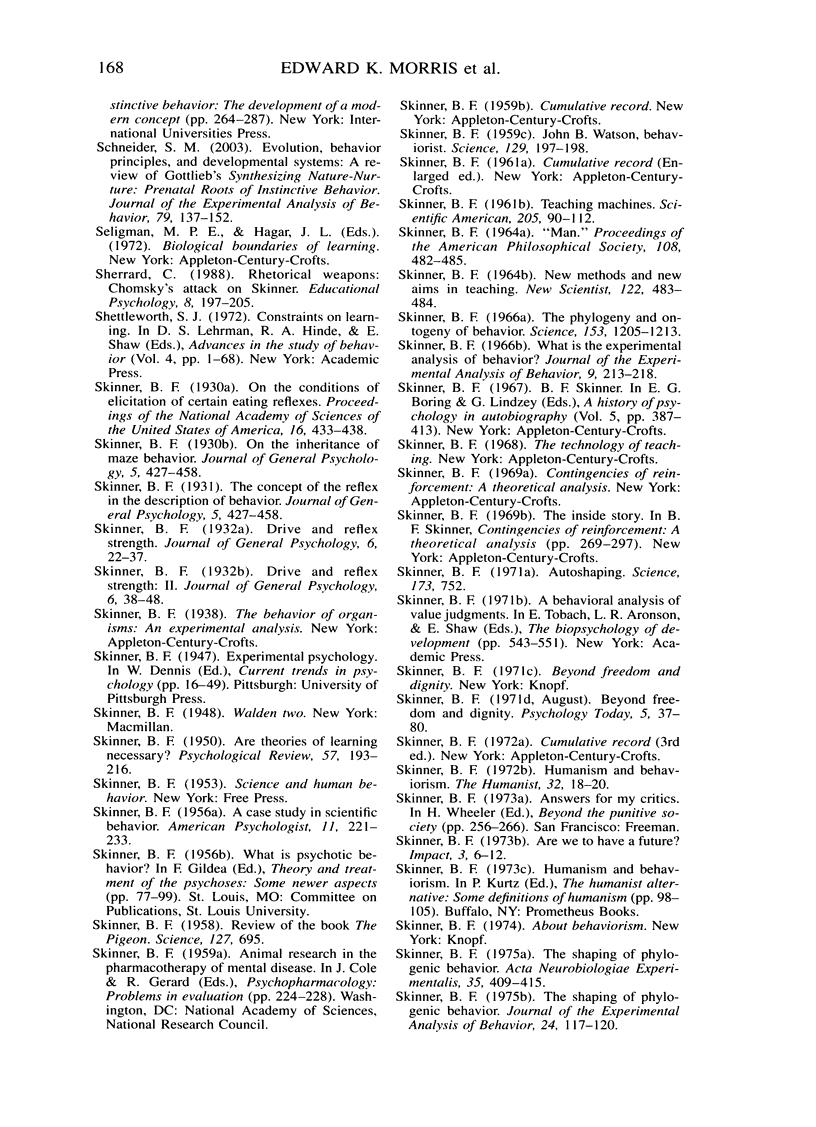

Selected References
These references are in PubMed. This may not be the complete list of references from this article.
- Catania A. C. The gifts of culture and of eloquence: An open letter to Michael J. Mahoney in reply to his article, "Scientific psychology and radical behaviorism". Behav Anal. 1991 Spring;14(1):61–72. doi: 10.1007/BF03392553. [DOI] [PMC free article] [PubMed] [Google Scholar]
- Czubaroff J. Criticism and response in the Skinner controversies. J Exp Anal Behav. 1988 Mar;49(2):321–329. doi: 10.1901/jeab.1988.49-321. [DOI] [PMC free article] [PubMed] [Google Scholar]
- Epstein R., Olson J. K. An index to B. F. Skinner's a matter of consequences. Behav Anal. 1985 Fall;8(2):209–233. doi: 10.1007/BF03393153. [DOI] [PMC free article] [PubMed] [Google Scholar]
- Epstein R., Olson J. K. An index to B. F. Skinner's the shaping of a behaviorist. Behav Anal. 1984 Spring;7(1):47–63. doi: 10.1007/BF03391885. [DOI] [PMC free article] [PubMed] [Google Scholar]
- Krantz D. L. Schools and systems: The mutual isolation of operant and non-operant psychology as a case study. J Hist Behav Sci. 1972 Jan;8:86–102. doi: 10.1002/1520-6696(197201)8:1<86::aid-jhbs2300080104>3.0.co;2-b. [DOI] [PubMed] [Google Scholar]
- Lee V. L. Comments about the isolation of behavior analysis. Behav Anal. 1989 Spring;12(1):85–87. doi: 10.1007/BF03392481. [DOI] [PMC free article] [PubMed] [Google Scholar]
- Medawar P. B. Fear and DNA. New York Rev Books. 1977 Oct;24(17):15–20. [PubMed] [Google Scholar]
- Moore B. R., Stuttard S. Dr. Guthrie and Felis domesticus or: tripping over the cat. Science. 1979 Sep 7;205(4410):1031–1033. doi: 10.1126/science.572990. [DOI] [PubMed] [Google Scholar]
- Morris Edward K., Smith Nathaniel G. Bibliographic processes and products, and a bibliography of the published primary-source works of B. F. Skinner. Behav Anal. 2003 Spring;26(1):41–67. doi: 10.1007/BF03392067. [DOI] [PMC free article] [PubMed] [Google Scholar]
- O'Donnell T. V., Welford B., Coleman E. D. Potroom asthma: New Zealand experience and follow-up. Am J Ind Med. 1989;15(1):43–49. doi: 10.1002/ajim.4700150106. [DOI] [PubMed] [Google Scholar]
- doi: 10.1901/jeab.2003.79-137. [DOI] [PMC free article] [Google Scholar]
- doi: 10.1901/jeab.1992.58-229. [DOI] [PMC free article] [Google Scholar]
- Parkins P. V. BioSciences Information Service of Biological Abstracts. Science. 1966 May 13;152(3724):889–894. doi: 10.1126/science.152.3724.889. [DOI] [PubMed] [Google Scholar]
- REYNOLDS G. S., CATANIA A. C., SKINNER B. F. Conditioned and unconditioned aggression in pigeons. J Exp Anal Behav. 1963 Jan;6:73–74. doi: 10.1901/jeab.1963.6-73. [DOI] [PMC free article] [PubMed] [Google Scholar]
- Reese H. W. How is physiology relevant to behavior analysis? Behav Anal. 1996 Spring;19(1):61–70. doi: 10.1007/BF03392739. [DOI] [PMC free article] [PubMed] [Google Scholar]
- SCHILLER P. H. Innate constituents of complex responses in primates. Psychol Rev. 1952 May;59(3):177–191. doi: 10.1037/h0062854. [DOI] [PubMed] [Google Scholar]
- SKINNER B. F. Are theories of learning necessary? Psychol Rev. 1950 Jul;57(4):193–216. doi: 10.1037/h0054367. [DOI] [PubMed] [Google Scholar]
- SKINNER B. F. John Broadus Watson, behaviorist. Science. 1959 Jan 23;129(3343):197–198. doi: 10.1126/science.129.3343.197. [DOI] [PubMed] [Google Scholar]
- Skinner B. F. Autoshaping. Science. 1971 Aug 20;173(3998):752–753. doi: 10.1126/science.173.3998.752. [DOI] [PubMed] [Google Scholar]
- Skinner B. F. Cognitive science and behaviourism. Br J Psychol. 1985 Aug;76(Pt 3):291–301. doi: 10.1111/j.2044-8295.1985.tb01953.x. [DOI] [PubMed] [Google Scholar]
- Skinner B. F. ON THE CONDITIONS OF ELICITATION OF CERTAIN EATING REFLEXES. Proc Natl Acad Sci U S A. 1930 Jun 15;16(6):433–438. doi: 10.1073/pnas.16.6.433. [DOI] [PMC free article] [PubMed] [Google Scholar]
- Skinner B. F. Psychology in the year 2000. J Exp Anal Behav. 2004 Mar;81(2):207–213. doi: 10.1901/jeab.2004.81-207. [DOI] [PMC free article] [PubMed] [Google Scholar]
- Skinner B. F. Selection by consequences. Science. 1981 Jul 31;213(4507):501–504. doi: 10.1126/science.7244649. [DOI] [PubMed] [Google Scholar]
- Skinner B. F. The evolution of behavior. J Exp Anal Behav. 1984 Mar;41(2):217–221. doi: 10.1901/jeab.1984.41-217. [DOI] [PMC free article] [PubMed] [Google Scholar]
- Skinner B. F. The evolution of verbal behavior. J Exp Anal Behav. 1986 Jan;45(1):115–122. doi: 10.1901/jeab.1986.45-115. [DOI] [PMC free article] [PubMed] [Google Scholar]
- Skinner B. F. The phylogeny and ontogeny of behavior. Contingencies of reinforcement throw light on contingencies of survival in the evolution of behavior. Science. 1966 Sep 9;153(3741):1205–1213. doi: 10.1126/science.153.3741.1205. [DOI] [PubMed] [Google Scholar]
- Skinner B. F. The shaping of phylogenic behavior. J Exp Anal Behav. 1975 Jul;24(1):117–120. doi: 10.1901/jeab.1975.24-117. [DOI] [PMC free article] [PubMed] [Google Scholar]
- Skinner B. F. The shaping of phylogenic behavior. Acta Neurobiol Exp (Wars) 1975;35(5-6):409–415. [PubMed] [Google Scholar]
- Skinner B. F. The species-specific behavior of ethologists. Behav Anal. 1980 Spring;3(1):51–51. doi: 10.1007/BF03392379. [DOI] [PMC free article] [PubMed] [Google Scholar]
- Skinner B. F. What is the experimental analysis of behavior? J Exp Anal Behav. 1966 May;9(3):213–218. doi: 10.1901/jeab.1966.9-213. [DOI] [PMC free article] [PubMed] [Google Scholar]
- Skinner C. A., Rumsby G. Steroid 11 beta-hydroxylase deficiency caused by a five base pair duplication in the CYP11B1 gene. Hum Mol Genet. 1994 Feb;3(2):377–378. doi: 10.1093/hmg/3.2.377. [DOI] [PubMed] [Google Scholar]
- Todd J. T., Morris E. K. Case histories in the great power of steady misrepresentation. Am Psychol. 1992 Nov;47(11):1441–1453. doi: 10.1037//0003-066x.47.11.1441. [DOI] [PubMed] [Google Scholar]
- VERPLANCK W. S. Since learned behavior is innate, and vise versa, what now? Psychol Rev. 1955 Mar;62(2):139–144. doi: 10.1037/h0044788. [DOI] [PubMed] [Google Scholar]
- de Waal F. B. The end of nature versus nurture. Sci Am. 1999 Dec;281(6):94–99. doi: 10.1038/scientificamerican1299-94. [DOI] [PubMed] [Google Scholar]


